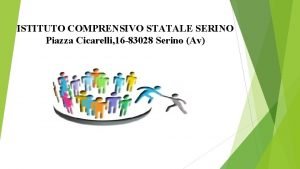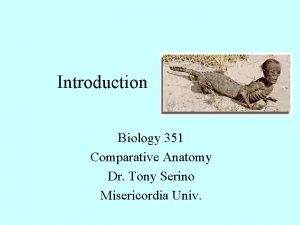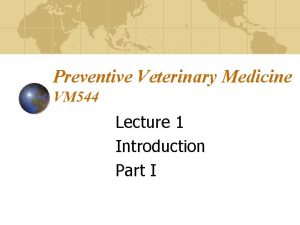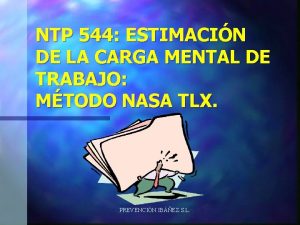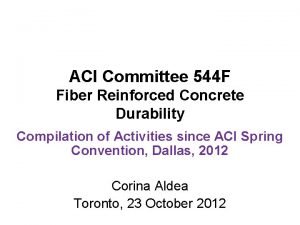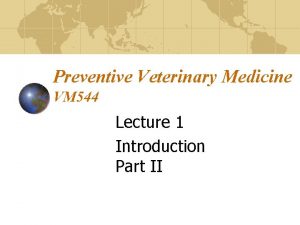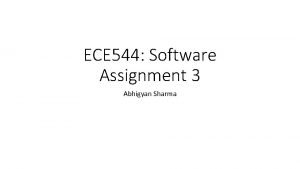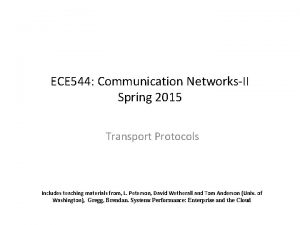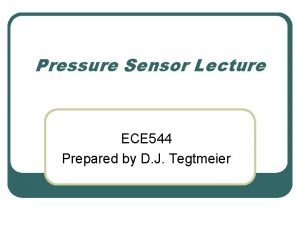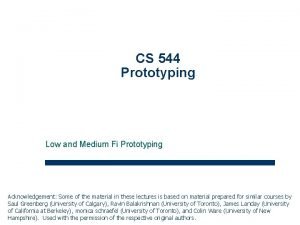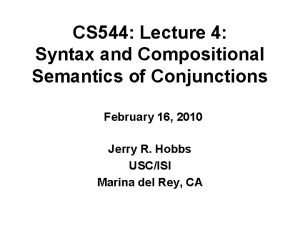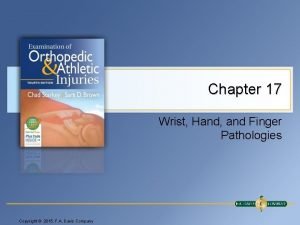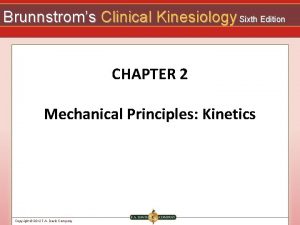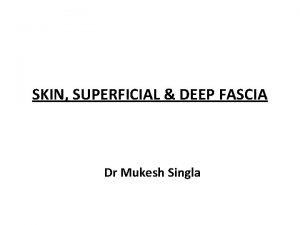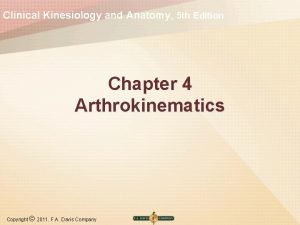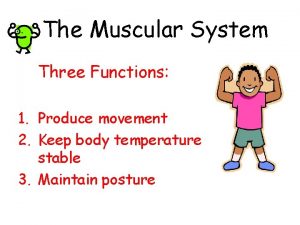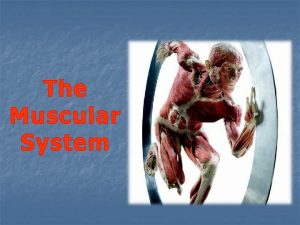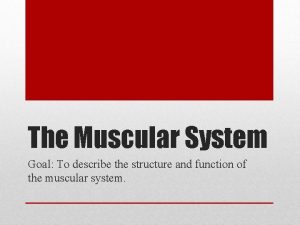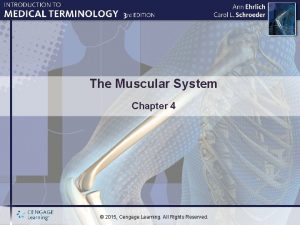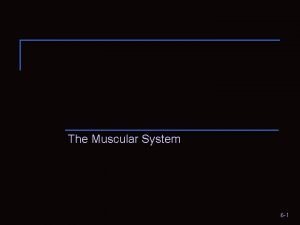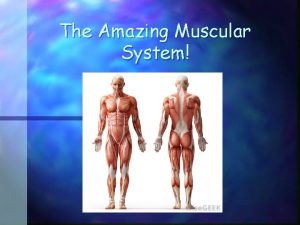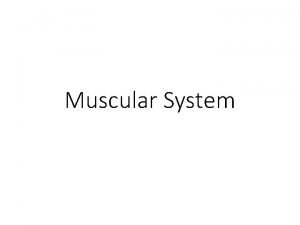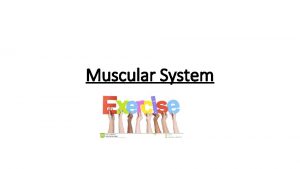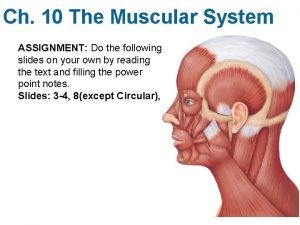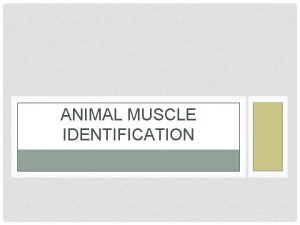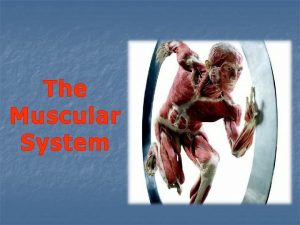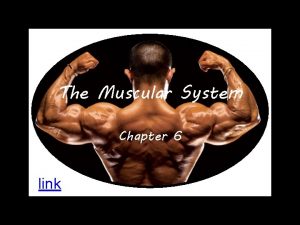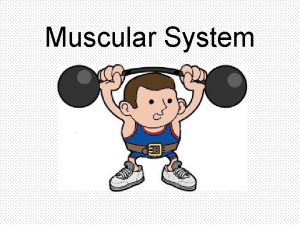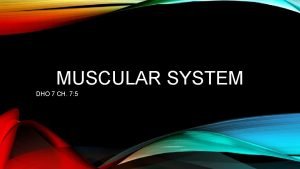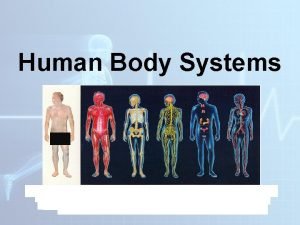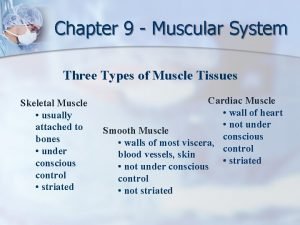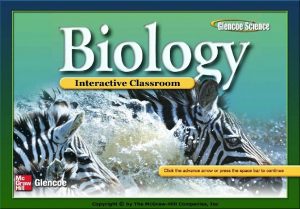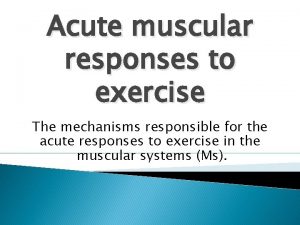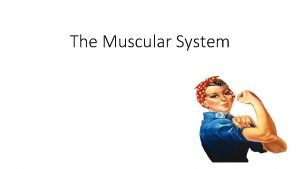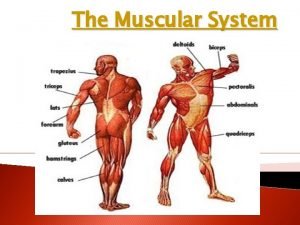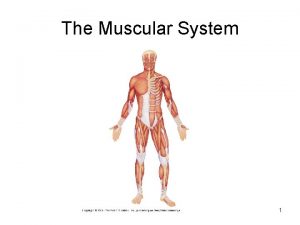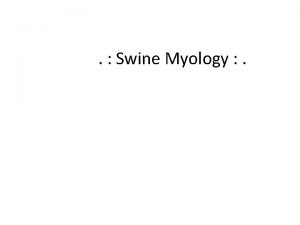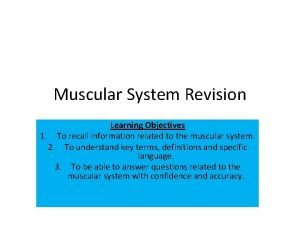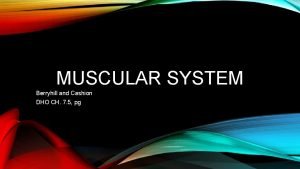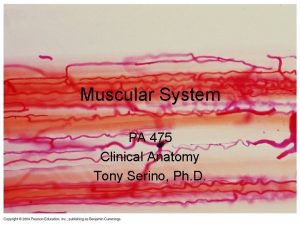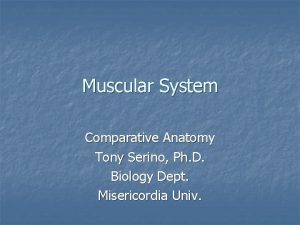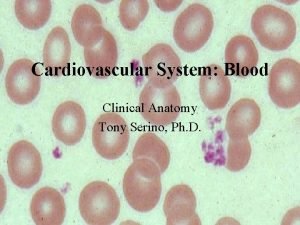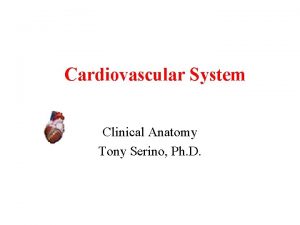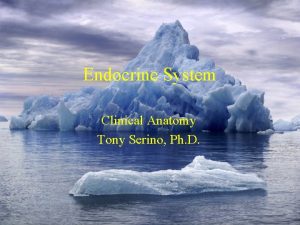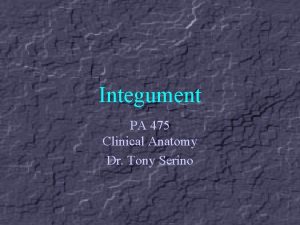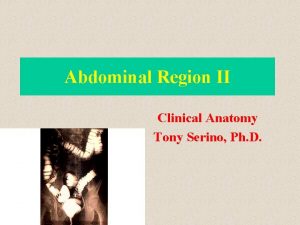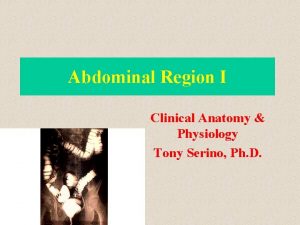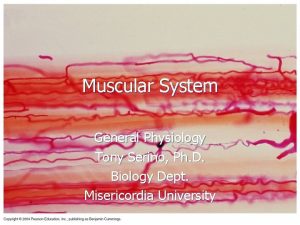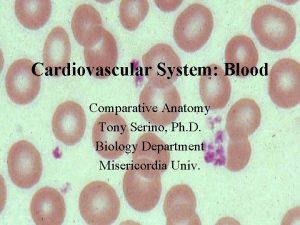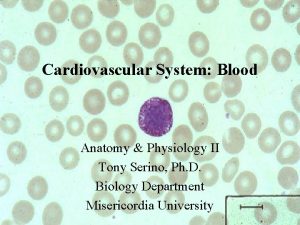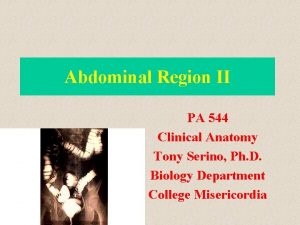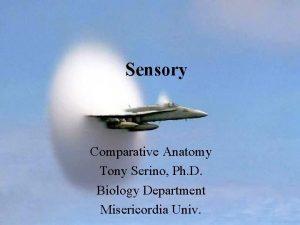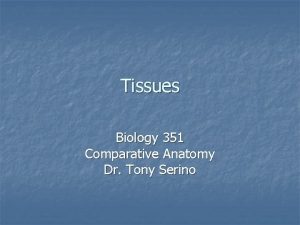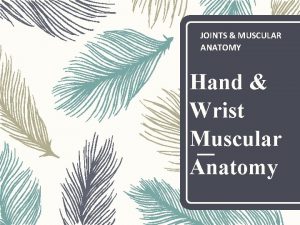Muscular System PA 544 Clinical Anatomy Tony Serino
















































- Slides: 48

Muscular System PA 544 Clinical Anatomy Tony Serino, Ph. D.

Muscle: Topic Objectives • Be able to describe and compare the types of muscle tissue and their histology • Be able to list and infer the functions and attributes of muscle tissue to physiological needs of the body • Be able to explain muscular physiology and compare the differences between types of muscle

Muscular System • Functions: § Movement –generation of force and/or shortening § Maintenance of posture § Joint stabilization § Heat Generation § Attributes: § contractility, irritability, extensibility, and elasticity

Types of Muscle Cells Skeletal Muscle –voluntary, striated Cardiac Muscle –involuntary, striated Smooth Muscle –involuntary, no striations

Muscles wrapped with CT, that is continuous with tendon and periosteum

The elasticity of the CT sheaths, tendon and the muscle cells = the Series Elastic Component

Antagonistic Muscle Arrangement This arrangement plus the series elastic component allows the muscle to return to its original length.

Skeletal Muscle Cells • Long, cylindrical, non-branching, multinucleated • 10 -100 mcm wide and up to 35 cm long • Voluntary, no spontaneous depolarization normally • Contractile proteins (myosin & actin) arranged in bundles called myofibrils

Develop as a fusion of myoblasts, which accounts for multinucleated cells, extra myoblasts remain as satellite cells.

Unique Muscle Cell Structures Sarcomere

Each skeletal muscle cell must be innervated by a motor neuron to begin contracting.

Neuronal AP triggers release of ACh at neuromuscular junction (motor end plate).

Neuromuscular Junction (Motor End Plate)

ACh is released and diffuses across gap and triggers a MEPP

The MEPP triggers an AP that races along the sarcolemma and down the T-tubules. The depolarization affects the SR cisternae which releases Ca++ into the cytoplasm. The rise of intracellular Ca++ triggers the mechanical events of contraction.

Muscle Cell Contraction (Excitation-Contraction Coupling) • A motor neuron is stimulated to fire an AP • AP reaches synaptic terminal triggering an influx of Ca++ • The Ca++ stimulates the release of ACh • ACh diffuses across cleft and binds to nicotinic receptors in motor end plate • This causes Na+ channels to open; causing the generation of a MEPP • The MEPP triggers an AP along sarcolemma and into T-tubules • This deplorarizes the SR cisternae which releases stored Ca++ into the cytoplasm

Each myofibril consists of overlapping thick and thin filaments arranged in units called sarcomeres.

Muscle Contraction: Mechanical Events (Sliding Filaments) • Calcium ions from SR flood the myofibrils • This causes the thick and thin filaments to bind to each other (generates tension) and may cause them to slide past each other • This causes the sarcomere to shorten

Myofibril Anatomy H Band M Line Z Line

Myofibril Structure (cross section) H Band Cross sections: M Line

Thick Filament Structure

Thin Filament Structure: Twisted bead chain of actin proteins

Thin Filament: Actin, Tropomyosin and Troponin

Calcium is trigger

Contraction Events Detachment

Detachment Reset: energize myosin head

Detachment Reset Attachment

Detachment Reset Power Stroke Attachment

Muscle Contraction Review

Muscles are arranged as Motor Unit = 1 motor neuron + all the muscle fibers it controls (innervates) The size of the motor unit depends on the degree of control needed in that particular whole muscle.

Biomechanics of Force Production • • Tension = force exerted on an object by a muscle Load = force exerted on muscle by the weight of an object Twitch = the mechanical response of a muscle to an AP Types of Contractions: • • Isometric = muscle increases tension without shortening Isotonic = muscle shortens with no further increase in tension Bicep Tension Load Fulcrum (pivot point) Weight of arm + object

Single Muscle Twitch

Factors Affecting Muscle Fiber Performance § Load –affects velocity of contraction • Increasing load decreases velocity § Frequency of stimulation § Initial Length of muscle fiber § Type of muscle fiber –fibers differ in strength, size, ATP splitting rate, and resistance to fatigue

Load Effect on Degree and Duration of Contraction

Load vs. Velocity of Contraction

Factors Affecting Muscle Fiber Performance § Load –affects velocity of contraction • Increasing load decreases velocity § Frequency of stimulation § Initial Length of muscle fiber § Type of muscle fiber –fibers differ in strength, size, ATP splitting rate, and resistance to fatigue

Increase frequency of stimulation allows tension to Mechanical add to previous contraction’s tension (Wave) Summation

Factors Affecting Muscle Fiber Performance § Load –affects velocity of contraction • Increasing load decreases velocity § Frequency of stimulation § Initial Length of muscle fiber § Type of muscle fiber –fibers differ in strength, size, ATP splitting rate, and resistance to fatigue

Initial Length of Muscle Fiber: affects the maximum tension that can be developed due to degree of overlap between thick and thin filaments

Factors Affecting Muscle Fiber Performance § Load –affects velocity of contraction • Increasing load decreases velocity § Frequency of stimulation § Initial Length of muscle fiber § Type of muscle fiber –fibers differ in strength, size, ATP splitting rate, and resistance to fatigue

Types of Muscle Fiber: each motor unit consists of only one type of muscle fiber • Slow twitch, red (oxidative) fibers (SO) –small diameter, weakest, slow ATPase, much myoglobin and mitochondria, abundant blood supply, fatigue resistant • Fast twitch, red (oxidative) fibers (FO) –medium diameter, moderate strength, fast ATPase, abundant mitochondria and myoglobin, good blood supply, moderate fatigue resistance • Fast twitch, white (glycolytic) fibers (FG) –largest diameter, great strength, fast ATPase, low amount of myoglobin or mitochondria, decreased blood supply, high in glycolytic enzymes, tire quickly

Control of Whole Muscle Tension dependent on: • Tension developed by each fiber – Dependent on fiber type, initial length and degree of wave summation • Amount of fibers stimulated to contract – The number of motor units responding is directly related to amount of tension produced – If the body needs more power, it recruits more motor units to respond – Known as recruitment (motor unit summation)

Energy Use: stored ATP in muscle used quickly so re-supply is crucial to function 1. Creatine Phosphate –quick re-supply, allowing time for aerobic respiration to gear up 2. Aerobic Respiration –oxidative phosphorylation dependent on adequate blood supply of oxygen, uses different sources for energy: a) b) c) 3. Stored glycogen Glucose and fatty acids from blood Fatty acids from blood Anaerobic Respiration -becomes dominant as need for oxygen exceeds ability of blood to transport it into muscles After exercise, energy continues to be consumed at increased levels to re-build reserves, etc. , this is the oxygen debt incurred during the exercise

Fatigue –inability to maintain contraction tension even while being stimulated. Two kinds: • Primary Fatigue –due to accumulation of lactic acid in sarcoplasm, this changes the cytoplasm p. H and begins to change protein configurations which ends contraction. • Secondary Fatigue –related to the loss of energy reserves in the body, as seen in day after soreness. Why this triggers a low intensity pain signal (a dull ache) is unknown.

Cardiac Muscle Striated, single nucleus, branched cells, connected together by intercalated discs (with many gap junctions) Spontaneously contracts, needs no innervation, involuntary

Smooth Muscle No sarcomeres, therefore, no striations, single nucleated, small spindle shaped cells Spontaneously contracts, involuntary control, can remain contracted for long periods of time without fatiguing Two types: Visceral (single unit) –united by gap junctions Multi-unit –needs innervations, behaves like skeletal muscle (Ex. Iris)

Smooth Muscle Cell

Visceral Smooth Muscle
 Istituto comprensivo serino
Istituto comprensivo serino Evidence from anatomy
Evidence from anatomy Differentiate muscular strength from muscular endurance
Differentiate muscular strength from muscular endurance Vm 544
Vm 544 Ntp 544
Ntp 544 Aci 544
Aci 544 2505447600
2505447600 Vm 544
Vm 544 Ece 544
Ece 544 Cse 544 sbu
Cse 544 sbu Tcp
Tcp Ece 544
Ece 544 Storyboard/low fidelity prototype
Storyboard/low fidelity prototype Cs 544
Cs 544 Copyright
Copyright Vestibular nerve
Vestibular nerve Clinical kinesiology and anatomy 6th edition
Clinical kinesiology and anatomy 6th edition Nasal cavity roof
Nasal cavity roof Malpighian layer of the epidermis
Malpighian layer of the epidermis Clinical kinesiology and anatomy 6th edition
Clinical kinesiology and anatomy 6th edition Three functions of muscular system
Three functions of muscular system Muscular system
Muscular system Function of muscular system
Function of muscular system Chapter 4 the muscular system learning exercises answer key
Chapter 4 the muscular system learning exercises answer key Unit 6:5 muscular system
Unit 6:5 muscular system Simple muscular system diagram
Simple muscular system diagram Muscle root words
Muscle root words Muscular system label
Muscular system label The muscular system chapter 6
The muscular system chapter 6 Muscular system head and neck
Muscular system head and neck Sheep muscular system
Sheep muscular system Regions of the body
Regions of the body Muscular system primary function
Muscular system primary function Chapter 6 the muscular system figure 6-12
Chapter 6 the muscular system figure 6-12 Whats the muscular system
Whats the muscular system Chapter 7:5 muscular system
Chapter 7:5 muscular system Aerobic respiration exercise
Aerobic respiration exercise Structures of the muscular system
Structures of the muscular system Active muscles
Active muscles Chapter 32 section 3 the muscular system
Chapter 32 section 3 the muscular system Muscular system response to exercise
Muscular system response to exercise How your muscular system works
How your muscular system works Human body muscle chart
Human body muscle chart Chapter 6 the muscular system figure 6-9
Chapter 6 the muscular system figure 6-9 Muscular system
Muscular system Superficial muscular system
Superficial muscular system Pig muscles labeled
Pig muscles labeled Muscular system learning objectives
Muscular system learning objectives Chapter 7:5 muscular system
Chapter 7:5 muscular system
